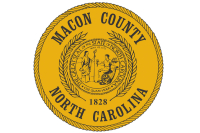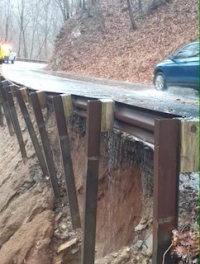Water Warrior: Former teacher helps students learn more about the importance of a precious resource
By Michael Beadle
Kathy Boydston was never one to sit quietly in retirement.
A veteran elementary school teacher, world traveler, mountain biker and marathon runner, she’s now keeping busy coordinating programs in Haywood County Schools that teach students about the importance of water quality.
Whether it’s testing pH levels in local streams, setting up student mentor programs, or helping to get new trees planted on school grounds, Boydston is having the time of her life doing what she does best — working with young people and inspiring others to take pride in the natural beauty of their surroundings.
As the water quality curriculum coordinator for Haywood County Schools, Boydston works with schools and environmental agencies to monitor water quality, develop curriculum connections to water-related lessons, and come up with innovative ideas that help students learn how water flows into their daily lives.
Related Items
Her part-time job, paid for by a grant through the Pigeon River Fund, began in the spring of 2004. The Haywood County Schools Foundation wrote and received the grant, and has continued the program for the past four years, according to Steve Brown of the Haywood County Schools Foundation.
One of the natural wonders of Haywood County is that all of its water begins within the county.
“And that is something that is certainly rare,” Boydston said. “We have such a wonderful watershed. Our water comes from the tops of mountains.”
So part of Boydston’s job is to encourage young students to become good stewards, to take care of this natural resource and learn how it can be endangered by pollution, sediment run-off, fertilizers and animal waste.
Boydston began her new job working with fifth-grade students, since that grade level had several strong curriculum connections to the topic of water. Learning how to use water sampling kits, students and their teachers went to nearby streams and river sites to collect water and test it for pH levels, temperature, turbidity (or clarity) and the amount of dissolved oxygen in the water. Based on the readings, the students learn what levels are safe for life to survive in the water. A pH level between 6 and 8, for example, will support life, and the higher the pH level within that range, the more opportunities for fish and other life forms to thrive.
All but three of the elementary schools in Haywood County have a nearby water source that’s readily accessible, so water testing often doesn’t require off-campus field trips. Boydston leads students to sample water outside as well as indoor sinks and water fountains. Students also bring in samples of well water and town water from their own homes.
“And not all of it is good,” Boydston said. About 10 years ago, she recalled, one school actually had to overhaul its drinking fountain system after water tests showed it was subpar.
Once students learn about water quality, the next lesson is to figure out what needs to be done when water isn’t as clean as it can be. Part of looking for the solution to water problems, according to Boydston, isn’t prodding students for set answers but encouraging them to come up with questions.
“You let them ask questions,” Boydston said. “They take an active part in what they want to know.”
Perhaps it’s ironic that this science-savvy teacher never took a science class while earning her undergraduate degree in business from Western Carolina University back in 1967. Though her mother was a teacher, Boydston steered toward business, but the market back then wasn’t keen on female executives.
“I’d’ve been a bank president for sure,” she declared.
So Boydston decided to give education a try — and never looked back.
“It was definitely my calling,” she said.
Having attended 17 schools before attending Western — her father, an engineer, took jobs all over the country and overseas — Boydston became a big fish on campus back when Western was about 1,800 students. She served as Catamount Yearbook Editor, wrote a weekly column for the college newspaper and now proudly displays her “WCU Cool” license plate.
A stickler for detail and a furious ball of energy, Boydston went on to earn her master’s and education specialist degrees in middle grades education at Western while teaching in elementary school. Imparting her travel experiences and a love of science and math, she garnered prestigious accolades along the way — North Carolina’s DARE Teacher of the Year, District Conservation Teacher of the Year twice, local Teacher of the Year twice, and a state finalist for Outstanding Elementary Teacher of the Year for science and math.
Boydston credits her father as the key inspiration behind her environmentally conscious efforts. Back in her teaching days, she also had a revelation visiting Belize’s rain forests teaming with life. She takes that sense of caring for natural resources everywhere she goes — even if it means picking up trash in a Western Carolina parking lot on a cold Saturday morning.
During her 35 years in education, Boydston was drawn to the philosophy that we learn by doing, so rather than simply reading about the water cycle in a textbook, her students would build self-contained terrariums that could sustain their own water cycles.
Boydston believes these kinds of hands-on learning experiences not only give students real-world applications to what they are studying in school, they also give students a chance to take an active role in protecting the quality of life wherever they may live.
“So kids really get into this now,” Boydston said. “You’ll have kids say, ‘Oh, this is cool!’”
And teachers across Haywood County are developing some really exciting programs that address water quality issues, she added. For example, as part of World Water Monitoring Day on Oct. 18, students collect water samples that can be compared with other water samples from all over the world.
To celebrate Earth Day, students and teachers at Junaluska Elementary School not only gathered recyclable materials, they used the items to make robots, flowers, car models and other works of art that were displayed on the school’s front lawn. Clyde Elementary School has its own nature trail, butterfly garden and outdoor classroom.
And not only are fifth-graders being taught how to take water samples. The fifth-graders are teaching this to fourth-graders, and now the water quality program has expanded to the eighth grade.
Boydston also helps coordinate meetings with the Haywood Environmental Initiative, an organization made up of environmental science teachers and representatives from local environmental agencies. Often times agencies like Haywood Waterways Association and the U.S. Fish and Wildlife Service have the best of intentions but may not know how to get their message into schools, so a person like Boydston, who has a background in the school system and in working with such agencies, can help bring the right people to the table.
“Kathy gets us all together,” says Gail Heathman, education coordinator for Haywood Soil and Water Conservation District. “She’s a catalyst. I consider myself fortunate in knowing Kathy.”
And Boydston delivers — whether it’s water testing kits for elementary schools or calling people to set up conservation activities for students.
“I can call on her for anything,” Heathman said.
Boydston is especially excited about a new collaboration this year between Blue Ridge Paper Products, local and regional water environmental agencies, and teachers and their students at Jonathan Valley Elementary School, Canton Middle School, Tuscola High School and Bethel Christian Academy. In an effort to re-introduce the striped shiner into the Pigeon River, local schools are housing giant fish tanks that will include several shiners, rocks for spawning and water from area creeks. Blue Ridge is covering the cost of the experiment, including the 55-gallon tanks. If the fish are able to live and spawn in the tanks, they’ll be put into the Pigeon River.
“It’s pretty cool,” said Mark Ethridge, a science teacher at Tuscola High School who is participating in the program. “We don’t know if it’ll work or not.”
Ethridge said he doesn’t know of any similar program of its kind in Western North Carolina.
“My kids love it,” he added. The students keep looking inside the tank each day to see if the fish are spawning. Ethridge jokes about adding some mood lighting and romantic music to put the fish in the right mood.
On a serious note, programs like these have been what Ethridge has been hoping to see in Haywood County for years — teacher training, environmental awareness, and the kinds of collaborations that generate great ideas when classroom teachers get together with environmental agencies.
“We’re slowly but surely progressing in that direction,” Ethridge said. “There’s all kinds of possibilities.”
If the shiner project is a success, perhaps students will be able to breed other fish in the classroom.
“I saw this as a golden opportunity,” Boydston said of the shiner project.
You can be sure she’ll be looking for that next great golden opportunity for students before the school year is over.









